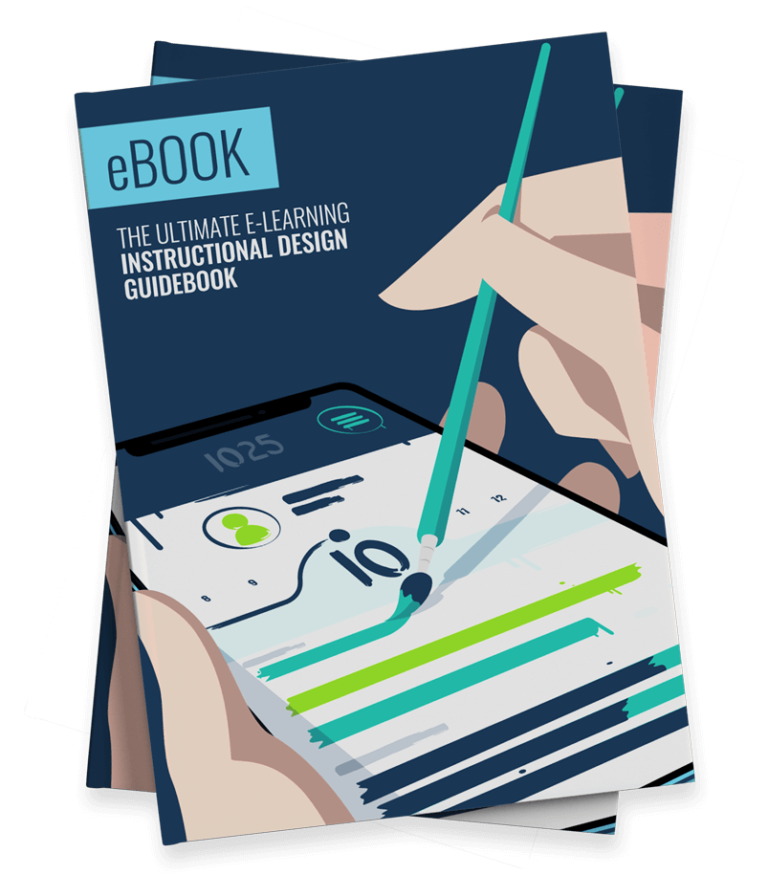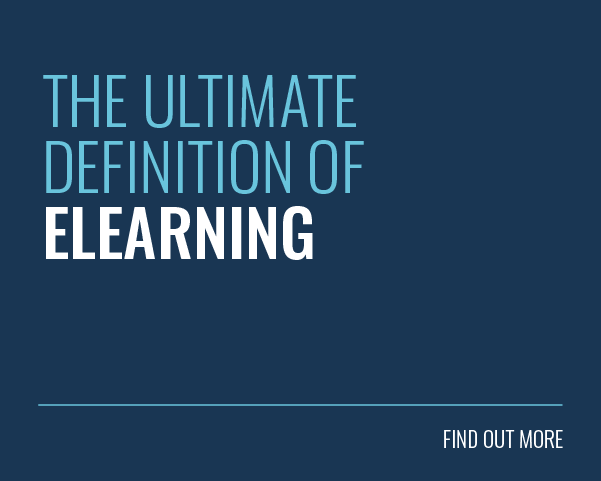
We live in the Information Age. This places new demands on us all. Learning and development must find ways to face these challenges and adapt to a rapidly changing world. Luckily, you can do so with instructional design!
Instructional design gives you the power to change the culture of your organisation. As a result, it’s one of the very best investments an L&D team can make.
Despite this, only 57% of organisations have the instructional design resources they need, even though 91% consider it a priority.
With everyone wanting to drive that number upwards, it’s worth exploring what instructional design is, its benefits, various models and the current challenges.
Are you ready? Let the instruction begin!
What Is Instructional Design?
Instructional design or instructional systems design (ISD), is a discipline that aims to design successful learning experiences. As a result, good instructional design considers how your learners learn and what materials, methods and technologies will be most effective in meeting their learning objectives.
These materials can include, for instance, online courses, instructional videos, tutorial manuals and learning simulations. As such, the experiences can be either digital or physical.
To ensure the experiences help your learners acquire and apply new knowledge, instructional design as a discipline follows a systematic approach of assessing needs, designing processes, developing materials and evaluating their effectiveness.

Typical models combine education, behavioural psychology and communication strategies to create the most effective training environments for specific groups of learners. This focus is important as it highlights how learners receive instruction that’s most impactful for them.
These experiences are created by instructional designers (IDs). They use their knowledge of how people learn to guide instructional sequences and strategies that meet the needs of your learners and achieve desired learning outcomes.
Amongst other skills, instructional designers are experts in finding the right technology to support good pedagogy. As a result, they are the linchpin of the instructional design process.
Origins of Instructional Design
The foundations for instructional design first emerged during World War II. Governments had to teach thousands of soldiers how to complete a variety of specific tasks in a short amount of time.
Complex activities were broken down into smaller tasks to ensure soldiers could better understand each step of the process. New training materials were created based on the principles of instruction, learning and human behaviour.
After the success of military training, psychologists moved their focus elsewhere. They began to view training as a system and developed various analyses, models and procedures.
After the war, this approach was built upon, leading to the development of instructional design as we know it today. Now, instructional design as an educational field marries cognitive and behavioural psychology.
In addition, today, the industry focuses on how to integrate technology and human-computer interactions into different instructional design models and methods.
Basic Components of Instructional Design
We will look at some of the most popular instructional design models later on in this article. These models and theories have different elements that help instructional designers develop successful learning experiences.
However, there are some primary components that define effective instructional design approaches and guide best practices. These include:
- Analysis that helps you to understand your training needs in order to define clear goals and objectives.
- Design and development of learning materials and determining the best delivery methods.
- Assessments that allow you to evaluate if your training initiatives were successful.
Together, clear learning goals and objectives, effective learning activities and assessments create the Magic Triangle of Learning. Meeting all these components ensures the most beneficial instructional design and learning outcomes.
Benefits of Instructional Design

Utilising instructional design theories can yield vast benefits for both learners and organisations. After all, it’s a systematic process rooted in theory and research.
This research-backed approach means that your learning objectives are aligned with your business objectives. It helps to provide your learners with access to high-quality training material that takes into account their strengths and weaknesses.
Similarly, your IDs collect, process and analyse vast amounts of data as part of an effective instructional design process. As a result, they can hone in on the training needs that will create the greatest ROI and generate real results for your organisation.
In addition, instructional design principles will force you to identify the purpose of your training endeavours before jumping into action. Thinking critically at this stage of your training project can make all the difference.
This, of course, means that you can eliminate the risk of missing your targets and wasting precious resources. Combined, these benefits typically make instructional design a more cost-effective approach to training.
Some other benefits include:
- Focused and customised learning programmes.
- Higher learner participation due to interactive design.
- Clear and measurable training objectives.
- A consistent approach to learning experiences and training content.
- Simplified learning for students.
Instructional Design Models
Throughout the years, the L&D world has seen various instructional design models that help instructional designers navigate the development of online learning projects. Each of these models has its strengths and weaknesses.
As such, you need to understand what training issue you are trying to solve before determining the best course of action and model to use.
Below, we have gathered five commonly used instructional design models. All instructional designers should be familiar with these frameworks. They help IDs to deliver the highest-quality training programmes.
Let’s have a look!
1. ADDIE
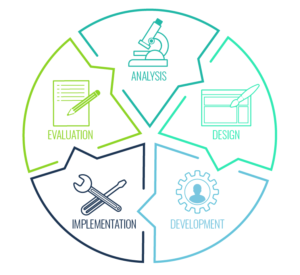
ADDIE is, without a doubt, the most popular instructional design model. Just like flares and disco, it’s been around since the 1970s. It outlines five different stages every training campaign goes through. These stages are:
1. Analysis
An in-depth analysis is an excellent place to begin when creating your training programme. After all, the analysis phase helps you to clarify the core components for a successful project.
First, you should focus on identifying your target audience. Second, you need to determine what that audience needs to know. You can do so by completing a training needs analysis.
2. Design
During the design stage, you need to work out how you’re going to meet the needs of your learners. As such, whatever you are seeking to achieve, ensure that your training programme addresses the key aspects you pinpointed in your analysis.
3. Development
It’s time to put your plan into action! To do so, you need to gather your existing plans and assets, storyboard your content and create multimedia to support learning delivery. Once you have all the necessary details to hand, it’s time to start building your content.
4. Implementation
At this stage you can see all your ideas come to life as it’s time to go live! This means that you will deliver your training programme to your learners, typically sending it straight to their learning management system using eLearning standards like SCORM or xAPI.
5. Evaluation
Last, but not least, it’s essential to focus on evaluation to understand how well the results of your training initiative matches the objectives you set for the learning programme.
Ultimately, evaluation gives you the recipe to make your training even better, as you can smooth out any wrinkles as soon as they appear.
2. Bloom’s Taxonomy
Bloom’s Taxonomy is a pedagogical framework that helps you to measure the cognitive development of your learners and set appropriate learning objectives. As a result, you can determine if your training programme is working as you intended.
Bloom’s Taxonomy highlights six levels of cognitive functioning that reflect the various mental processes we go through when mastering a new concept. In the original model (1956), these six levels were described with nouns:
- Knowledge
- Comprehension
- Application
- Analysis
- Synthesis
- Evaluation
However, the model has developed greatly over the years. One of the biggest changes came with the Revised Taxonomy (2001). This updated framework replaces these previously used nouns with verbs and places greater importance on creating:
- Remember
- Understand
- Apply
- Analyse
- Evaluate
- Create
This hierarchical structure allows you to track your learner’s depth of understanding effectively. They can move up a level only after they have mastered the verbs associated with the previous one.
Therefore, true expertise requires learners to go through all six levels to ensure they are able to apply their newfound knowledge effectively.
The different levels help you categorise learning objectives into varying levels of complexity based on your learners’ unique needs and current skill levels. This is essential in order to create individualised education plans.
3. SAM Model
The Successive Approximation Model (SAM) is a simplified version of the previously discussed ADDIE model. Unlike ADDIE, SAM focuses on eliciting feedback and building working models earlier in the process.
While there are different versions of the framework, the simplest SAM model consists of three parts. These parts are Preparation, Iterative Design and Iterative Development:
- Preparation phase involves gathering all needed information and context for your project.
- Iterative design phase focuses on prototyping the materials so that all interested parties can review the design.
- Iterative development phase focuses on developing, implementing and evaluating the finished prototype.
SAM places great emphasis on iteration. In fact, it’s the basis for this model. After all, each step is meant to be evaluated, repeated and revisited if necessary.
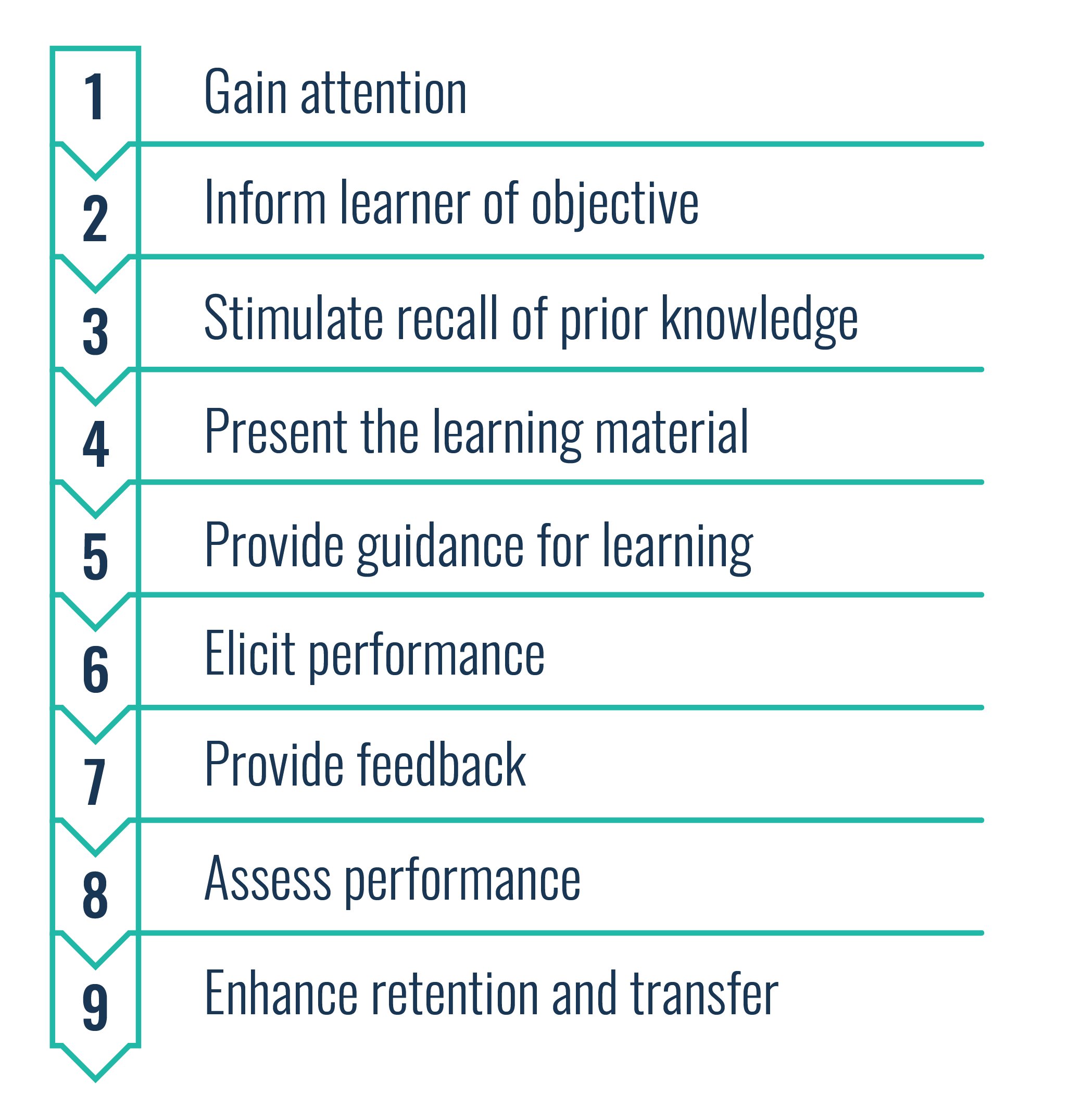
4. Robert Gagne’s Nine Events of Instruction
Robert Gagne’s Nine Events of Instruction revolutionised learning and development programmes and education as a whole. Gagne identified the mental conditions adults need for effective learning.
Based on his findings, Gagne created his framework to address the conditions of learning. He proposes that learners experience nine steps when being taught something. These steps are further broken down into three categories:
1. Preparation
- Gaining attention
- Informing learners of the objective
- Stimulating recall prior to learning
2. Instruction and Practice
- Presenting the stimulus
- Providing learning guidance
- Eliciting performance
- Providing feedback
3. Assessment and Transfer
- Assessing performance
- Enhancing preparation and transfer
These nine steps follow a systematic instructional design process and create a flexible learning model. After all, these events can be adapted to cater to different learning situations.
As a result, Gagne’s Nine Events of Instruction is one of the most commonly used and well regarded instructional design models.
5. Merrill’s Principles of Instruction (MPI)
David Merrill’s Principles of Instruction (MPI) is a problem-centred strategy for instructional design. In fact, he suggests that effective learning experiences are rooted in problem-solving.
This framework integrates five principles of learning. These are:
- Task-centred principle highlights how learning starts with real-world tasks or problems that your learners can relate to.
- Activation principle suggests that activating your learner’s existing knowledge helps them to connect new information to existing skills.
- Demonstration principle advises that your training courses must deliver information in various formats so that they leverage different regions of the brain. This helps to increase knowledge retention.
- Application principle suggests that your learners must apply new knowledge on their own and learn from their mistakes to ensure effective knowledge retention.
- Integration principle highlights how discussion, reflection and presentation of new knowledge helps to integrate it into the real world.
As such, according to the model, learning is promoted when instruction is problem-centric and activates existing knowledge. In addition, it needs to include demonstrations and opportunities for real world application.
What Are The Challenges Facing Instructional Design?
The world of L&D is developing at the same speed as technology advances. This, of course, means that new challenges pop up all over the place.
But don’t fret. These are challenges that we can overcome together. Let’s have a look at some of the most common issues!
1. One Man Team
Instructional designers need an increasingly diverse skill set to keep up with ever evolving training needs. For instance, some typical skills requirements include:
- Project management
- Research
- Evaluation and data handling
- Stakeholder management
- Learning theory and instructional strategies
- Learning design
- Coding or basic programming
- Graphic, video or game design
Finding someone who can spin each of these plates successfully is near impossible. Therefore, it’s essential for instructional designers to have a good understanding of their own strengths and weaknesses.
This helps them to improve their skills and delegate tasks. They’ll be able to find colleagues who can support them or software that can aid them. For instance, Growth Engineering Authoring Tool allows your IDs to create best in class eLearning without any coding knowledge!
2. Staying Current with Educational Technology
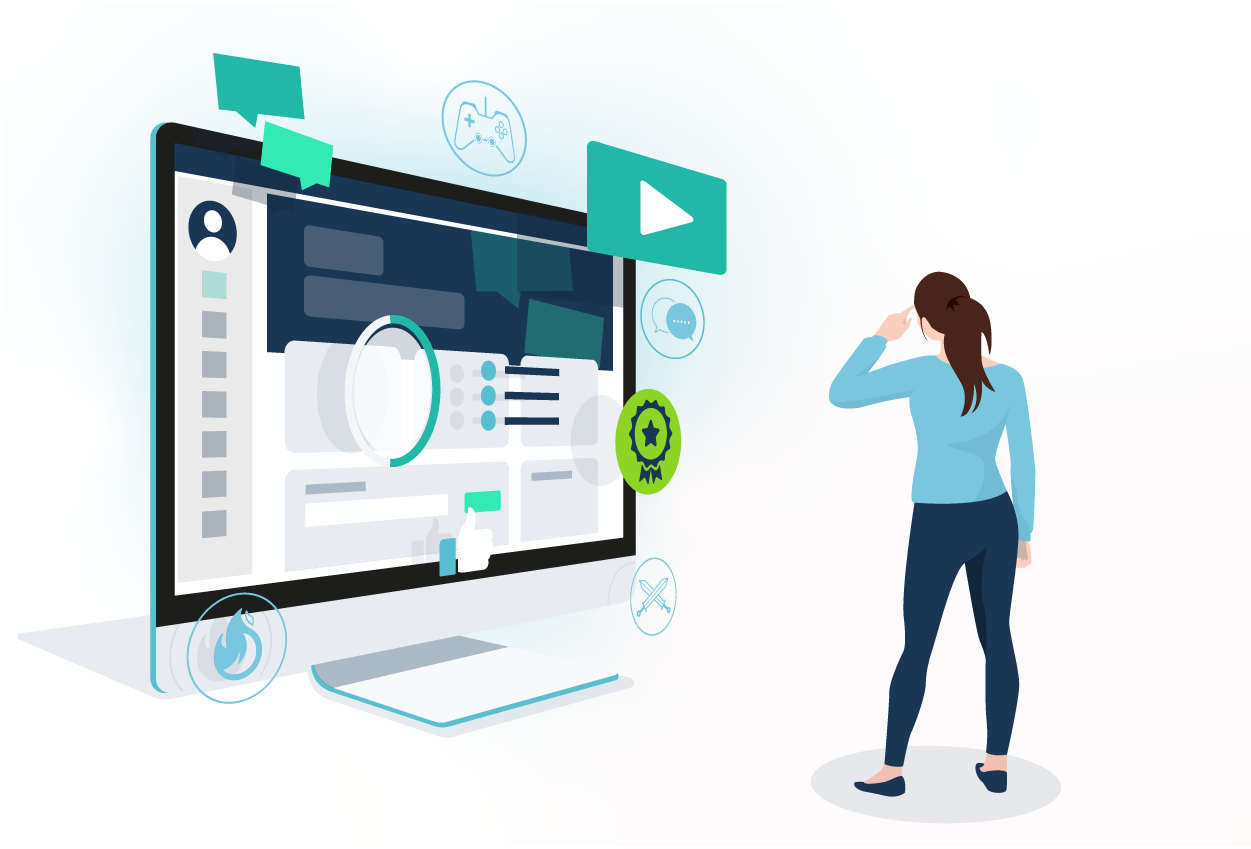
New learning tools are popping up faster than you can say ‘augmented reality enhanced deep learning experience’! As a result, staying ahead of the curve is harder than ever before!
Luckily, with a NextGen LMS, your instructional designers no longer have to worry about the next big thing. After all, these tools are always developing new functionality to help you stay ahead of the curve!
3. Combatting Disengagement
Ever since Gallup found that 87% of employees are disengaged at work, engaging your people has become business-critical.
Training is known to be an effective route to employee engagement. As such, instructional designers are on the front line in the war against dull online learning.
But engaging learners is no easy feat! It takes real expertise to perfect the recipe for irresistible learning. Luckily, Growth Engineering are the A-team when it comes to engagement. Our solutions combine gamification, personalisation and social learning to guarantee you get it right!
The Future of Instructional Design
The business world has changed dramatically over the last few years. This means that organisations and their learning functions have changed too. It is now clearer than ever just how critical it is to find the most effective ways to reach your learners.
This need has increased the demand for instructional design. Before, the focus lay in working out how to deliver training effectively, with little thought about how to make it engaging. Now, instructional design has matured, which means that the focus has shifted.
This is not surprising as there are plenty of tools at your disposal that focus on effective training and increasing engagement. For instance, gamification, social learning and personalisation are now common sure-fire winners.
But these are not the only trends currently prevailing in the industry. Let’s explore what the future of instructional design has in store!
1. Change in Attitudes
There is a growing recognition of the value of the instructional design discipline. It’s no longer seen as an add-on to traditional training. It is its own entity that is supported by theory.
This increased popularity has sparked new interest in the industry. Similarly, there is bigger awareness of different instructional design approaches and tasks.
As a result, organisations, learners and IDs alike realise that organisational training can be highly engaging and can help them to become the person they want to be.
This change in mindset will promote instructional design as an essential tool in the online training toolbox.
2. Microlearning

Microlearning is not a new concept. In fact, it has been around for a while and started gaining traction in the 1990s. But in terms of instructional design, microlearning is quickly becoming modern learners’ favourite way to learn.
According to microlearning theories, instructional designers should focus on creating materials in small digestible segments. As a result, learners can access training materials more conveniently and never waste the spare time they have.
Ultimately, your instructional designers can meet their learners wherever they are, while saving some time and resources. After all, these units are quicker to create. And what’s even better, microlearning can increase learner engagement by 50%!
3. Continuous Learning
Effective learning doesn’t happen in one event. Instead, it’s a journey that takes place over time as your learners absorb, contextualise and put new knowledge into practice.
Considering this, instructional design is moving away from planning isolated training events. To accommodate this change, your instructional designers can maximise both engagement and knowledge retention through a campaign-based approach to training.
Drip-feeding training interventions over time helps you to create a continuous learning experience that transforms behaviour. In fact, you can wave goodbye to the dreaded Forgetting Curve. In addition, focusing on engagement ensures your learners are always hungry for more knowledge!
4. Narrative
Narrative and the use of stories as a vessel for instruction is by no means a new concept. In fact, it goes back thousands of years.
However, recent neuroscientific research found that the human brain organises memories into stories. This highlighted the importance of storytelling and brought it back into the L&D spotlight.
Weaving your instruction into a compelling narrative is an excellent way to engage your learners while increasing comprehension and retention.
5. Agile Learning
Flexibility, creativity and innovation are increasingly valued in today’s business environment. As a result, agile and iterative training design has become more popular.
In agile learning, L&D is a two-way street. This means that your employees keep L&D clued in on industry changes, and then L&D rapidly provides the support and training to respond.
In addition, instructional designers are also increasingly borrowing elements from the areas of User Experience (UX) Design and Design Thinking to maximise learning impact and create truly agile learning environments.
Final Words
With instructional design, you can engage your learners, change behaviour and transform your organisational culture. Ultimately, it’s your tool for organisational change.
Gone are the days when training content was randomly put-together presentations or lengthy documents designed to bore your learners into submission Today’s modern learning technology enables your instructional designers to create content that your learners want to complete.
And as we know, when training is about engaging your learners, it’s better for them and your organisation. With these approaches, creating effective training interventions doesn’t have to be hard.
Are you hungry for more instructional design knowledge? Our popular instructional design guidebook gives you all the tools you need to create effortlessly engaging learning experiences.

